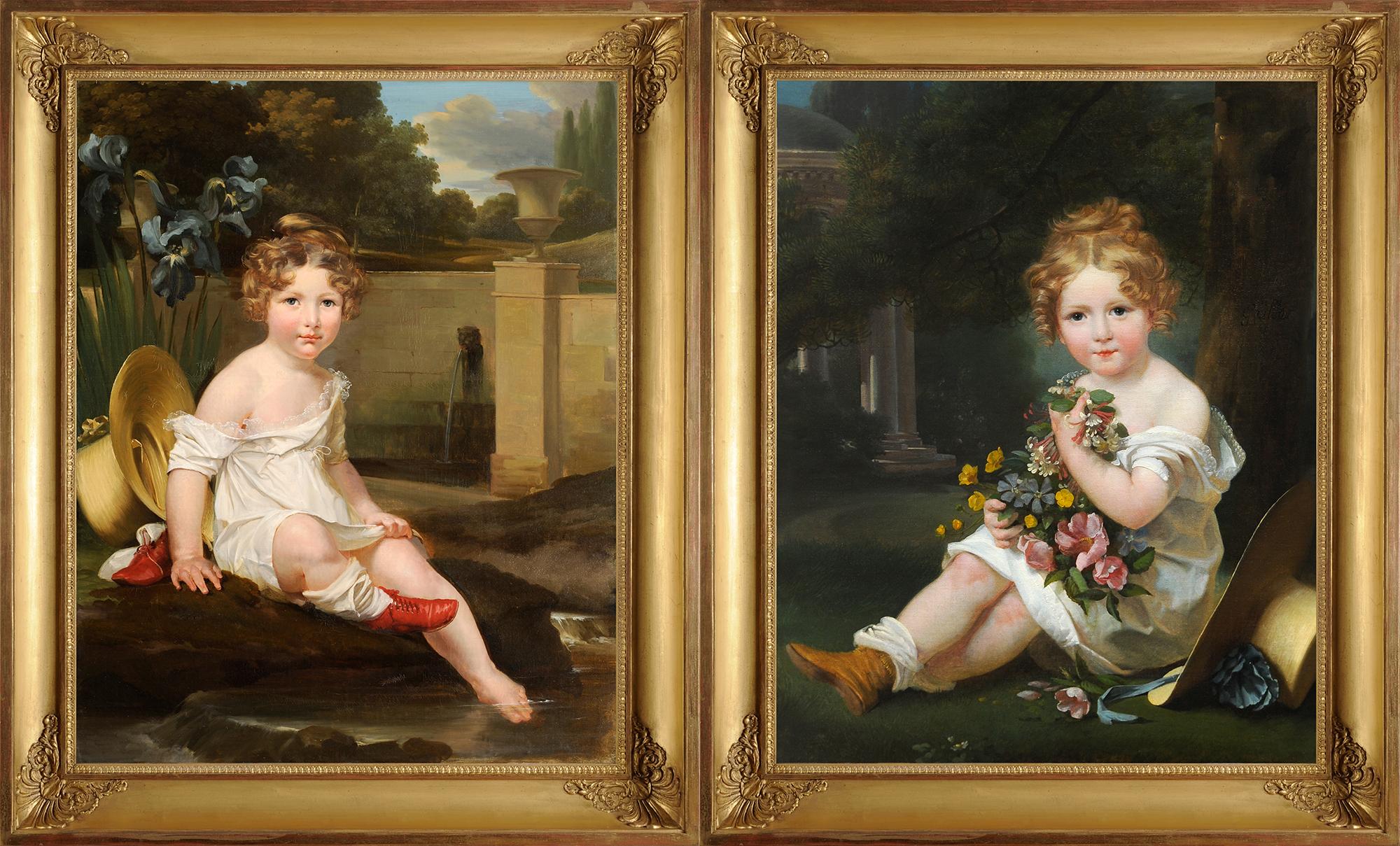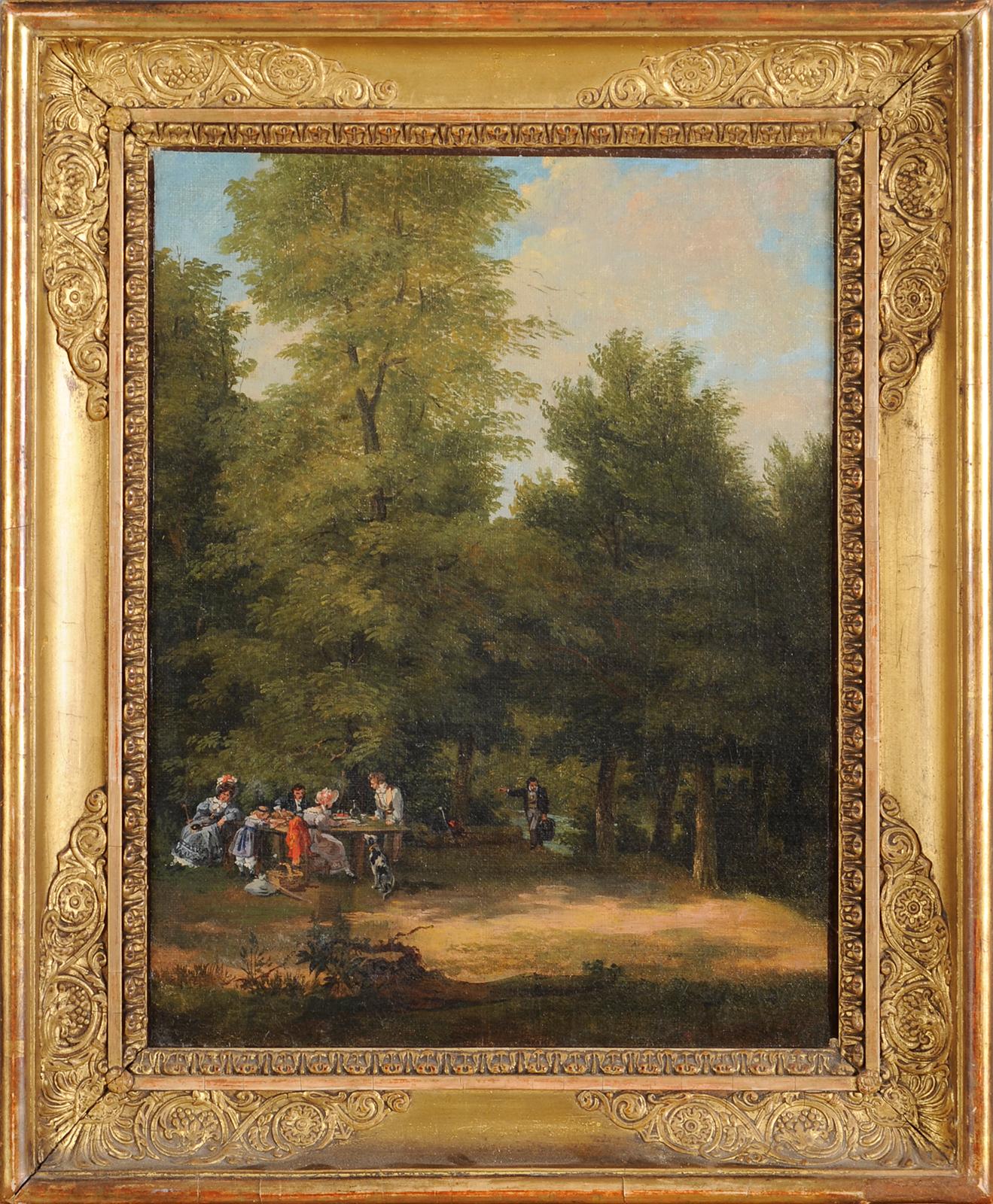Items Similar to Lady in a red dress with a kitten
Want more images or videos?
Request additional images or videos from the seller
1 of 10
Joseph BailLady in a red dress with a kitten
About the Item
Signature lower right: J. Bail
Relined and some restorations
Joseph-Claude Bail was born during a period of intense disagreement in the Parisian art world. For several years the Salon juries had rejected many progressive artists works; printmaking was making a charge at establishing itself as a true art form; the Barbizon group of painters challenged the tradition of historical landscapes with their views of the modern countryside, and Realism was decades old and had brought forth such combative figures as Gustave Courbet. Yet not all artists can be said to belong to this modern view of the nineteenth century. Numerous artists found prestige and public acclaim both at the Salons and with the public with works that relied on past styles and traditions influenced by the “Little Masters” from seventeenth-century Holland and traditions from eighteenth-century France. Joseph Bail belongs to this group; not an artist who sought to align himself with the increasing stylistic anarchy of the late nineteenth century, but one who carefully examined the changing needs of his patrons and gauged the underpinning social propensities of the time. Bail continued the tradition of Realism exemplified by Théodule Ribot and François Bonvin and received positive feedback which reinforced the continued respect for scenes reminiscent of daily life during the earlier years in France.
Joseph Bail was born on January 22nd, 1862 in Limonest in the Rhone region of France. His father, Jean-Antoine Bail, was a trained genre painter who was heavily influenced by the Dutch masters and focused his attention on depicting scenes from daily life. It is clear that Joseph, as well as his brother Frank, followed in the footsteps of his father, as he too would be influenced by these artists despite new interests in subjects and representation during this period in France.
In a period of increasing modernity and industrialization, Bails paintings glorified the past ways of life in France and found a sympathetic audience in bourgeois patrons.
Presumably beginning at a young age, Joseph’s initial artistic training began with his father who instilled in him a respect for the eighteenth-century French painters such as Jean-Siméon Chardin and the Dutch masters and encouraged him to view their works at the Louvre. As all three members of the family, Jean-Antoine, Franck, and Joseph, were artists, the Bail family represents one of the few associations of family painters of the Realist tradition remaining during the latter half of the nineteenth century. They could often be found exhibiting alongside one another at the annual Salons, showing work that displayed similar qualities in their subject. After beginning his training under his father, Bail began studying, presumably between 1879 and 1880, in the atelier of Jean-Léon Gérôme, an accomplished painter and teacher of the period. This was a short-lived period of tutelage as in 1882 Gérôme was no longer listed in Salon catalogues as Bail’s teacher, perhaps because Gérôme’s choice of subjects differed quite dramatically from those of his father and those that Bail would follow for the majority of his career.
Just after his sixteenth birthday, Bail debuted at the Salon of 1878, alongside both his father and brother, with Nature Morte (Still Life). The still life tradition in France was invigorated by the work of Jean-Siméon Chardin in the eighteenth century and still lives continued to be a major interest for many artists and many occupied themselves primarily with this type of painting. They figured as an important element of Bail’s work, and many of his genre scenes also show still life arrangements within the picture, even when they were not the primary focal point.
While still lifes dominate Bail’s beginning work shown at the Salon, he expanded his early themes to also include scenes from the countryside, animals, and genre paintings. As his style progressed, he showed a stronger affinity with his father’s work and that of the Chardin and the Dutch masters, choosing to portray room interiors illuminated by a strong light source. In recalling these past masters and this type of painting, Bail was appealing to the growing middle class as his work referenced earlier highly esteemed painters. Emmanuel Bénézit wrote of Bail and his interiors, that:
He excels at creating in all of his painting a very lively bright light due to the radiant shine of some brilliant point or to the direct projection of the exterior daylight…it’s assuredly the expression of original and rather harmonious art. His technique is very delicate and his colouring just right. The composition of his painting, always elegant, is skillfully treated.
Bail regularly submitted to the Salons and towards the end of his careers was “hors concours”, or exempt from having to submit his works for jury approval. He received awards in 1885 (Honorable Mention), 1886 (third-class medal), 1887 (second-class medal), 1889 Exposition Universelle (silver medal), 1900 Exposition Universelle (gold medal), and 1902 (medal of honor). He was also named Chevalier de la Légion d’Honneur in 1900, and was a member of the Société des Artistes Français. He died on November 26, 1921.
- Creator:Joseph Bail (1862 - 1921, French)
- Dimensions:Height: 19.69 in (50 cm)Width: 15.75 in (40 cm)
- Medium:
- Movement & Style:
- Period:
- Condition:
- Gallery Location:Gent, BE
- Reference Number:1stDibs: LU2140211045932
About the Seller
5.0
Vetted Seller
These experienced sellers undergo a comprehensive evaluation by our team of in-house experts.
Established in 2018
1stDibs seller since 2022
Typical response time: 1 hour
- ShippingRetrieving quote...Ships From: Gent, Belgium
- Return PolicyA return for this item may be initiated within 10 days of delivery.
More From This SellerView All
- Children playing in a forestLocated in Gent, VOVAmédée Elié Servin — (1829-1884) : Children playing in a forest A nice and confidently painted scene of three children playing in the midst of a dark forest. Through clever use of colour and light and dark effects, Elié Servin creates a mysterious and fairytale-like scene in which all attention is drawn to the playing children. Amédée-Élie Servin (1829-1884) Servin Amédée-Élie was a French painter and engraver, founder of the artistic community of Villiers-sur-Morin. Servin was born to a tanner, who, disappointed by his son's failure in his studies, apprenticed him to an upholsterer where he learned to draw cartoons. He then entered the École des Beaux-Arts and studied under the painter Michel Martin Drolling. At this school, he befriended students of his generation, such as Jean-Jacques Henner, Benjamin Ulmann and Paul Baudry...Category
1880s French School Figurative Paintings
MaterialsOil, Canvas
- Washerwomen by the river, oil on canvas by Karl GirardetLocated in Gent, VOVThis painting is part of a series of paintings Girardet made of washerwomen by the river. Upon their presentation they had a considerable success, which endures till now. In 2008 another painting of this series was sold at Christie's . Karl Girardet was born in 1813 in Le Locle, which at the time was part of France but is now part of Switzerland. Girardet lived and worked most of his life in Paris. After beginning his career as a painter of landscapes, he became a well-known history painter. As a confidant of the French king Louis Philippe I...Category
Late 19th Century Realist Figurative Paintings
MaterialsCanvas, Oil, ABS
- Picking Flowers By Frederic Ferdinand Koch (1863-1923)Located in Gent, VOVPicking Flowers by Fréderic Ferdinand Koch (signed lower right) Provenance: Galerie Berko Frederic Koch was a painter and pastellist of figures, compositions, still lives, drafts...Category
Early 20th Century Impressionist Figurative Paintings
MaterialsOil
- Interior of church Oil on panel - Enrique MÉLIDA (1838 – 1892)Located in Gent, VOVEnrique Mélida y Alinari, (1838 - 1892) Enrique Mélida was a Spanish painter, lithographer and writer. Through his marriage to Marie Bonnat, he is the brother-in-law of the painter ...Category
19th Century Figurative Paintings
MaterialsCanvas, Oil
- The Matchmaker, oil on canvas by Jan Baptist LambrechtsBy Jan Baptist LambrechtsLocated in Gent, VOVJan Baptist LAMBRECHTS (Antwerp, 1680 - after 1731), L'entremetteuse Canvas. On verso, wax stamp. 40 x 31 cm Expert : M. René MILLET Lambrechts was born in Antwerp in 1680. His fathe...Category
17th Century Figurative Paintings
MaterialsCanvas, Oil
- Farewell, oil on panel by Johannes Stroebel (1821-1905)Located in Gent, VOVFarewell, oil on panel by Johannes Stroebel (1821-1905) Length: 25 (unframed) Height: 32 (unframed) Signed on the right Presented in its original frame Johannes Anthonie Balthasar S...Category
19th Century Figurative Paintings
MaterialsCanvas, Oil
You May Also Like
- Mediterranean shore, probably the French RivieraLocated in BELEYMAS, FRJean-Baptiste-Arthur CALAME (Geneva, 1843 - Geneva, 1919) Mediterranean shore, probably the Côte d'Azur Oil on canvas mounted on cardboard H. 24 cm; L. 30 cm Signed lower right Circa...Category
1870s French School Figurative Paintings
MaterialsCanvas, Oil
- Young woman portrait with her dogBy Francois Kinsoen (Kinson)Located in BELEYMAS, FRFrançois-Joseph KINSON (Bruges 1770 – Bruges 1839) Portrait of a young woman near a spring, accompanied by her dog Oil on canvas H. 73 cm; L. 60 cm circa 1815-1817 We owe this elega...Category
1810s French School Figurative Paintings
MaterialsCanvas, Oil
- View of Châteaudun castle and city in FranceLocated in BELEYMAS, FRFrançois-Edme RICOIS (Courtalain, 1795 - Mareil-Marly, 1881) View of Châteaudun Oil on canvas H. 65 cm; W. 98 cm Signed and dated lower center 1860 François-Edme Ricois although bor...Category
1840s French School Figurative Paintings
MaterialsCanvas, Oil
- Pointillist Painting "The Road Beneath the Snow" Eugène Bégarat (French, 1943)By Eugène BégaratLocated in SANTA FE, NMPointillist Painting "The Road Beneath the Snow (Le Chemin Sous la Neige)" Eugène Bégarat (French, 1943) Oil on canvas 15 3/4 x 31 1/2 inches Saturated with winter's light glinting...Category
20th Century French School Landscape Paintings
MaterialsCanvas, Oil
- Portraits of two sistersLocated in BELEYMAS, FRBernard GAILLOT (Versailles 1780 – Paris, 1847) Portraits of two sisters Pair of oil on canvas H. 92 cm; L. 73 cm One signed Student of David, he presented his first works at the Salon of 1810. Mainly known for his portraits of children, his work does not seem extremely vast. More than a dozen religious paintings are kept in large Parisian or provincial churches (Val de Grâce, Saint-Denis, Notre Dame des Victoires, Collégiale d'Eu, etc.), and a few paintings on historical subjects are kept at the Palace of Versailles, made during major orders from Louis-Philippe for the opening of the Versailles Museum. He also produced numerous humorous drawings, mainly in wash, some of which were engraved. Our two portraits of little girls most certainly represent sisters and had remained in the family until today. Unfortunately, time has made them lose their identity... One is shown sitting at the foot of a tree, in front of a kiosk with very beautiful neoclassical architecture. She holds in her arms a multitude of freshly picked flowers, which she holds awkwardly. His sister with her little red patent shoes...Category
Early 1800s French School Figurative Paintings
MaterialsCanvas, Oil
- Picnic in the forestLocated in BELEYMAS, FRCircle of Xavier LEPRINCE (Paris 1799 - Nice 1826) Picnic in the forest Oil on canvas H. 36 cm; L. 26 cm This picnic scene places us around 1825/35, which makes it a rare representa...Category
1820s French School Figurative Paintings
MaterialsCanvas, Oil





